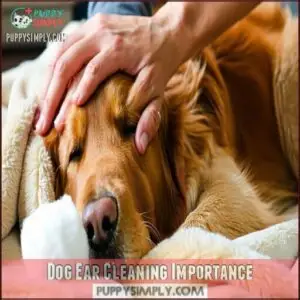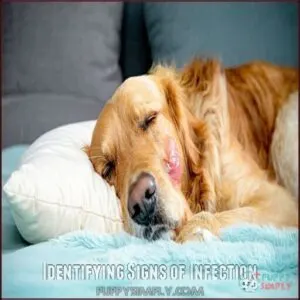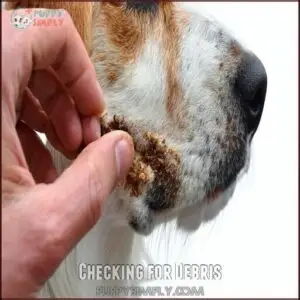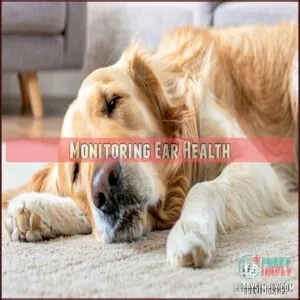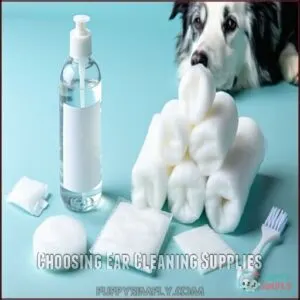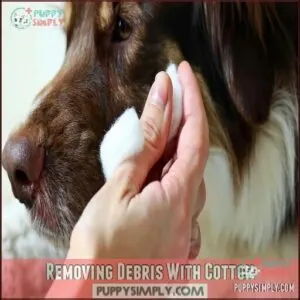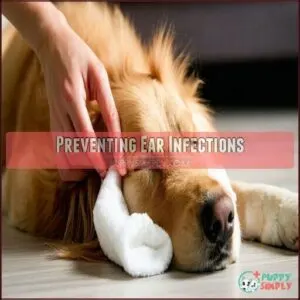This site is supported by our readers. We may earn a commission, at no cost to you, if you purchase through links.
 To clean your dog’s ears, start by inspecting them for dirt, redness, or odor—these can be signs of an infection.
To clean your dog’s ears, start by inspecting them for dirt, redness, or odor—these can be signs of an infection.
Use a vet-recommended ear cleaning solution, cotton balls (never Q-tips), and a gentle hand. Tilt your pup’s head, fill the ear canal with the solution, and massage the base for 30 seconds to loosen debris.
Let your dog shake their head (it’s messy but helpful!), then use a cotton ball to wipe away the gunk. Be gentle and avoid going too deep.
Regular cleaning keeps ears healthy, but if something seems off, don’t hesitate to call your vet. Small steps, big health wins are the result of regular ear cleaning, and it’s essential to be gentle and to avoid going too deep.
Table Of Contents
- Key Takeaways
- Dog Ear Cleaning Importance
- How to Clean Dogs Ears
- Ear Inspection Techniques
- Choosing Ear Cleaning Supplies
- Ear Cleaning Process Steps
- Preventing Ear Infections
- Maintaining Ear Health Routine
- Frequently Asked Questions (FAQs)
- Can you clean your dog’s ears at home with Q-tips?
- How do you clean wax out of a dog’s ears?
- What can I clean my dog’s ears with at home?
- How do you get brown gunk out of a dog’s ear?
- Can you use hydrogen peroxide to clean a dog’s ears?
- Should I clean the gunk out of my dogs ears?
- How do I remove ear wax from my dog?
- How do you clean a dog ear?
- How to clean your dog’s ears at home?
- Do dogs need ear cleaning?
- Conclusion
Key Takeaways
- Inspect your dog’s ears regularly for redness, discharge, or odors to catch early signs of infection.
- Use a vet-recommended cleaning solution with cotton balls or gauze; avoid Q-tips to prevent pushing debris deeper.
- Gently fill the ear canal with the solution, massage the base for 20-30 seconds, let your dog shake, and wipe visible debris.
- Dry your dog’s ears after swimming or bathing to prevent moisture buildup and reduce the risk of infections.
Dog Ear Cleaning Importance
Cleaning your dog’s ears is essential for preventing painful infections, reducing dirt buildup, and keeping their overall ear health in check.
By making it a regular part of your routine, you’ll help them stay comfortable and avoid serious issues down the line.
Preventing Infections
Preventing dog ear infections is all about keeping those ears clean and healthy. Regular dog ear cleaning can help avoid moisture buildup, which is a breeding ground for bacteria.
Regular ear cleaning prevents moisture buildup, stops bacteria growth, and keeps your dog’s ears comfortable, healthy, and infection-free.
Be mindful of your dog’s breed predisposition and manage any allergies effectively.
- Practice moisture control after swimming or bathing.
- Groom regularly to remove excess hair.
- Address allergies promptly.
- Maintain a balanced diet for overall ear health.
Reducing Dirt Buildup
Keeping dirt at bay in your dog’s ears guarantees a healthier, happier pup.
Some breeds are prone to buildup, especially those with floppy ears or hair inside their canals.
Regular dog ear cleaning, paired with preventative grooming like hair removal, helps reduce trapped debris.
Environmental factors like dirt or dust also increase cleaning frequency, keeping ear wax under control, which is crucial for maintaining a happier pup.
Monitoring Health
To boost your dog’s ear health, regular checks and examinations are a must. You’ll spot issues early by looking for clear infection signs like redness or discharge.
Here’s how to monitor effectively:
- Sniff for unusual odors—trust your nose!
- Watch for behavioral changes like head shaking.
- Check for ear infection symptoms such as swelling or tenderness.
This approach will help you monitor effectively and ensure your dog’s ear health by catching clear infection signs early.
How to Clean Dogs Ears
Cleaning your dog’s ears doesn’t have to feel like a chore. It’s an essential part of dog ear care, ensuring a healthy pup.
First, choose a vet-recommended dog ear cleaning solution and avoid anything homemade or containing alcohol.
Here’s how to clean dog ears efficiently:
- Prepare supplies: Use cotton balls or gauze, not Q-tips, as they can push debris deeper.
- Apply solution: Gently fill the ear canal with the cleaner, then massage the base for 20-30 seconds.
- Remove debris: Let your dog shake their head to loosen debris, then wipe visible areas clean.
Remember, breed predispositions or excessive hair may require professional groomers.
Ear Inspection Techniques
Regular ear inspections help you catch early signs of infection, like redness, discharge, or unusual odors, before they worsen.
By checking for debris and monitoring your dog’s ear health, you guarantee their ears stay clean and comfortable, and free from irritation.
Identifying Signs of Infection
You’ll know something’s off when your dog starts shaking its head more than usual.
Shaking their head excessively? It’s a clear signal—your dog’s ears might need attention to stay healthy and infection-free!
Check for ear infection signs like redness severity, ear discharge, or a dog ear odor.
Pain indicators may show up through whimpering or flinching during touch.
Behavioral changes, such as irritability, also matter.
Odor detection is key—strong smells often signal trouble, and it is crucial to identify trouble.
Checking for Debris
When inspecting your dog’s ears, look for visible debris, excessive wax, or foreign objects.
Gently check the ear canal for unusual discharge or signs of a mite infestation.
Any accumulation of ear debris can indicate cleaning is overdue.
Regular ear inspections help maintain dog ear health, ensuring your furry friend stays comfortable and free from potential issues.
Cleaning also prevents ear wax buildup.
Monitoring Ear Health
Spotting Infection Early Signs during regular ear inspections can save you headaches.
Check for redness, swelling, unusual ear odor, or discharge.
Some breeds have a predisposition to ear issues, while Allergy Manifestations might cause itching or inflammation.
Monitor for Aural Hematoma or Hearing Changes.
Pair ear cleaning and regular examinations to catch problems early and protect your dog’s ear health effectively.
Choosing Ear Cleaning Supplies
Choosing the right supplies guarantees your dog’s ear cleaning is safe and effective.
Stick to veterinary-approved solutions, cotton balls, and gauze, and steer clear of harmful items like Q-tips or harsh chemicals.
Selecting Ear Cleaning Solution
Picking the right ear cleaning solution safeguards your dog’s comfort and health.
Look for:
- Veterinary-recommended solutions for specialized care.
- Antifungal options to curb infections.
- Alcohol-free formulas to avoid irritation.
- Quality over homemade solutions with questionable ingredients.
- Ingredients that dissolve wax safely.
The best dog ear cleaner combines safety and effectiveness, ensuring cleaner, healthier ears without harm.
Regular cleaning can help prevent potential ear infections through the use of a good cleaner, such as those found at potential ear infections, which is a key factor in maintaining your dog’s healthier ears.
Using Cotton Balls and Gauze
Using cotton balls and gauze is key for safe and effective ear cleaning.
Cotton material pairs well with a dog ear cleaner, ensuring gentle wiping and debris removal.
Skip cotton swabs—they can push debris deeper.
Wrap gauze around a finger for better control, then use light pressure and safe techniques to clean dog ears without causing discomfort.
Many pet owners find it convenient to buy these supplies in bulk.
| Item | Purpose | Benefit | Tip |
|---|---|---|---|
| Cotton Balls | Gentle cleaning | Removes debris | Use for surface cleaning |
| Gauze | Precise application | Better control | Wrap around your finger |
| Dog Ear Cleaner | Loosens wax | Easier debris removal | Use veterinarian-approved |
| Finger | Gentle pressure tool | Avoids irritation | Clean only visible areas |
Avoiding Harmful Ingredients
When choosing a dog ear cleaner, avoid alcohol dangers and peroxide risks, as they can irritate sensitive ears.
Stick to safe alternatives like veterinary-approved solutions, which are free from irritating additives.
Homemade solutions may seem tempting, but they carry risks. Always prioritize products designed for ear cleaning safety to guarantee your dog stays comfortable and healthy.
Consult your vet for recommendations.
Ear Cleaning Process Steps
Cleaning your dog’s ears properly is essential to keeping them healthy and free from infections.
By following a few simple steps, you can safely remove dirt and debris while preventing discomfort.
Filling Ear Canal With Solution
Pour a small amount of ear cleaning solution directly into the ear canal. To guarantee ear cleaning safety, avoid inserting the bottle tip inside. Use a gentle application to prevent irritation, and make sure the solution temperature is lukewarm for your dog’s comfort.
You can find a suitable dog ear cleaner online. Watch your dog’s reaction—if they resist too much, pause and try again.
- Use lukewarm solution.
- Avoid inserting the bottle tip.
- Apply gently to prevent irritation.
- Monitor your dog’s response closely.
Massaging Ear Base
Massaging the ear base is vital. Gently rub for 20-30 seconds, promoting dog comfort and loosening debris.
This improves circulation benefits and helps medication absorption if needed. A thorough ear massage enhances ear care and is a key ear cleaning technique.
| Massage Benefits | Why It Matters |
|---|---|
| Loosens debris | Easier to clean ears effectively |
| Boosts circulation | Promotes healing and comfort |
| Medication absorption | Helps treatments work properly |
| Relaxes your dog | Makes ear cleaning stress-free |
| Essential for ear care | Reduces health risks |
Removing Debris With Cotton
After massaging the ear base, gently use cotton balls to remove loosened debris. Focus on visible areas inside the ear flap, using soft movements.
Avoid cotton swabs to prevent pushing debris deeper. Stick to shallow cleaning depth, only reaching where your finger fits comfortably. Swab alternatives like gauze work too.
Dog ear cleaners with antimicrobial properties can further assist in this process. These ear cleaning tips protect delicate areas while keeping debris visibility low, and are an essential part of ear cleaning and maintaining good hygiene.
Preventing Ear Infections
Preventing ear infections starts with keeping your dog’s ears clean, dry, and free from debris.
Regular inspections and prompt cleaning after swimming or bathing are key to maintaining healthy ears and avoiding unnecessary discomfort.
Reducing Moisture Buildup
Prevent ear infections by reducing moisture buildup. After bathing or swimming, dry your dog’s ears using cotton balls or a towel to absorb excess fluid.
Avoid trapping water in the canals by managing ear hair and ensuring proper ventilation.
Use a veterinarian-approved solution, free of harsh ingredients, as part of your ear cleaning routine. Reliable drying techniques matter, and it is crucial to prevent ear infections by reducing moisture buildup and using the right methods, such as those that are free of harsh ingredients.
Cleaning After Swimming
Swimming dogs often trap water in their ears, making ear infection prevention a must.
Post-swim cleaning helps remove moisture and debris. Use safe drying techniques like a towel or cotton ball to absorb water.
Ear cleaning after swimming reduces risks of swimmers ear, especially for breeds prone to issues. Consistent ear cleaning water removal keeps canals healthy and infection-free.
Regular Ear Inspections
Regular ear inspections are a must for dog health.
These checks help with early detection of issues and reinforce the ear cleaning importance.
Inspection frequency depends on breed predisposition, like floppy-eared dogs needing extra care.
Combine professional exams with your ear cleaning routine.
Educating yourself guarantees ear cleaning benefits, like spotting problems early, maintaining health, and tailoring ear cleaning maintenance.
Consider using apple cider vinegar to balance ear pH.
Maintaining Ear Health Routine
Keeping your dog’s ears clean and healthy requires a consistent routine suited to their specific needs, such as breed and activity level.
Regular ear care helps prevent infections, minimizes discomfort, and guarantees your pet stays happy and healthy, which is crucial for their overall well-being.
Establishing Cleaning Schedule
Setting a proper ear cleaning schedule helps you stay on top of your dog’s health.
Consider their breed, age, activity levels, and environment when planning.
Floppy-eared breeds or those in humid areas may need more frequent cleaning.
Always include veterinarian guidance in your routine to tailor dog ear cleaning maintenance to their specific needs for lasting ear health.
Factors Affecting Frequency
Ear cleaning frequency depends on breed predisposition, activity levels, and environmental factors.
Floppy-eared dogs, breeds with heavy ear hair growth, and those swimming often or exposed to allergens may need frequent cleaning.
Allergies also influence cleaning needs, as they increase debris and irritation.
Adjust based on your dog’s unique lifestyle, noticing signs of ear infections or buildup regularly to stay proactive.
Signs of Healthy Ears
Spotting healthy ears isn’t tricky if you know what to look for.
During ear cleaning or an ear examination, check for these signs:
- Pink color inside the ear with no redness.
- Odor absence, ensuring no bad smell.
- Minimal wax, not excessive buildup.
- Clear discharge, free of debris.
- Calm behavior when touched, indicating comfort.
Good ear hygiene promotes health! A healthy ear typically shows light brown ear wax.
Frequently Asked Questions (FAQs)
Can you clean your dog’s ears at home with Q-tips?
You shouldn’t clean your dog’s ears with Q-tips.
They can push debris deeper into the canal, causing damage or infections.
Instead, use cotton balls or gauze with veterinarian-approved ear-cleaning solutions for safer, effective results.
How do you clean wax out of a dog’s ears?
Imagine your dog struggling with wax buildup.
Gently lift the ear flap, pour a vet-approved cleaning solution into the ear canal, massage the base, let them shake it out, then wipe debris with cotton balls.
What can I clean my dog’s ears with at home?
You can clean your dog’s ears with a veterinary-recommended ear-cleaning solution, cotton balls, or gauze.
Avoid using Q-tips, water, or alcohol-based products, as these can push debris further or cause irritation.
How do you get brown gunk out of a dog’s ear?
Think of your dog’s ear as a tiny, delicate cave.
To remove brown gunk, use a vet-approved ear-cleaning solution, gently massage the base, and wipe visible debris with cotton balls or gauze—never go too deep!
Can you use hydrogen peroxide to clean a dog’s ears?
You shouldn’t use hydrogen peroxide to clean your dog’s ears.
It can irritate sensitive tissues inside the ear canal.
Instead, stick with a vet-recommended ear cleaner that’s safe and specifically made for dogs.
Should I clean the gunk out of my dogs ears?
Gunky ears are a gateway to grime and germs, so it’s essential to clean them gently.
Use a vet-recommended solution, avoid Q-tips, and consult your vet first if there’s redness, pain, or odor.
How do I remove ear wax from my dog?
Gently lift your dog’s ear flap, apply a veterinary-recommended ear-cleaning solution to the canal, and massage the base for 20-30 seconds.
Afterward, let your dog shake, then wipe away wax and debris with a cotton ball.
How do you clean a dog ear?
Lift your dog’s ear flap, apply a vet-approved cleaner into the canal without inserting anything deep, massage the base gently.
Let them shake.
Wipe away debris with cotton or gauze for a clean finish.
How to clean your dog’s ears at home?
Start by inspecting your dog’s ears for redness or debris.
Then, apply a vet-approved cleaner, massage the base gently, let them shake out excess, and wipe the outer ear with cotton balls or gauze.
Do dogs need ear cleaning?
Imagine your dog’s ears as windows into their health.
Regular ear cleaning prevents infections, reduces debris, and guarantees comfort.
It’s essential, especially for floppy-eared breeds or frequent swimmers, to maintain their overall well-being.
Conclusion
Like a stitch in time saves nine, regularly cleaning your dog’s ears can prevent discomfort and serious infections.
By knowing how to clean dogs ears, you guarantee your furry friend stays happy and healthy.
Use the right supplies, inspect regularly for signs of trouble, and follow a gentle, consistent routine.
Don’t rush the process, and always reach out to your vet if something seems off.
With care and patience, clean ears lead to a content, wagging tail, and a happy and healthy life!

